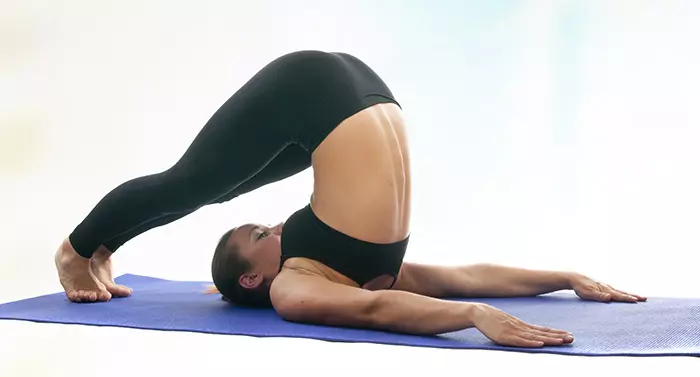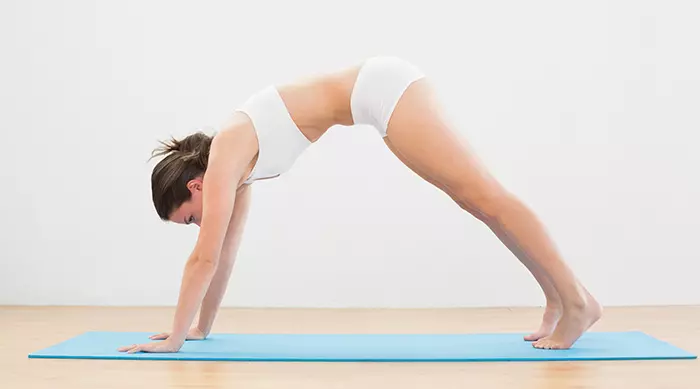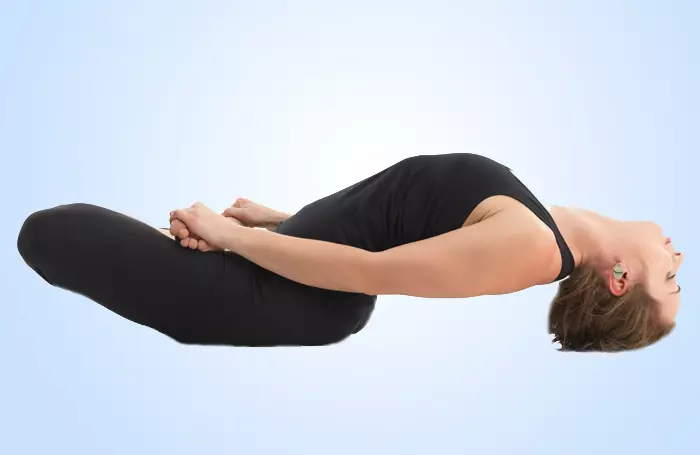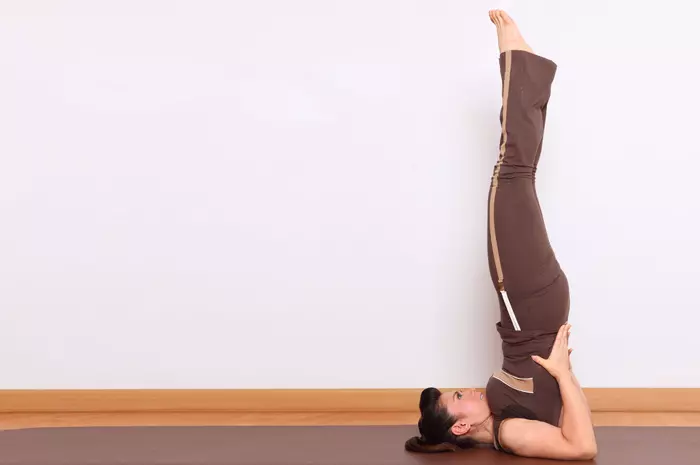11 Effective Yoga Asanas To Stimulate Your Nervous System
Improve your cognitive health and functioning with yoga postures that benefit your nervous system.

Image: shutterstock
Yoga can help you get rid of a cough, stretch your muscles, reenergize your body, relieve menstruation cramps, and help you stay in shape. It also plays a role in improving your nervous system. Yoga, a holistic practice that transcends physical fitness, offers a profound pathway to mental clarity and emotional equilibrium. Certain yoga asanas stimulate your nervous system, promote mindfulness and rejuvenation, cultivate a sense of overall well-being, and provide many other benefits. Keep reading to know more!
 Did You Know?
Did You Know?In This Article
Yoga For The Nervous System
Yoga asanas date back several centuries, originating in ancient India. They are a set of mindful exercises and meditation techniques that help achieve an overall balance between physical and mental well-being. All yoga asanas, or poses, are aimed at strengthening certain aspects of the body, and all of them can have a positive effect on the nervous system.
Notable benefits of yoga on your nervous system include (2):
- Reduced stress and anxiety
Yoga practices like deep breathing and meditation stimulate the PNS (peripheral nervous system), promoting relaxation and reducing the body’s stress response. It can also help regulate stress hormones like cortisol, leading to a calmer state of mind.
Yoga incorporates mindfulness techniques that can help individuals to focus on the present moment, reducing anxiety and worry. Regular yoga practice can also enhance emotional regulation skills, allowing individuals to better manage stress and negative emotions.
- Enhanced focus and concentration
Yoga can improve brain function by increasing blood flow to the brain and stimulating neural activity. Yoga practices, particularly meditation, can enhance mindfulness and attention span, improving focus and concentration.
- Improved emotional well-being
Yoga can help balance neurotransmitters like serotonin and dopamine, linked to mood regulation. Yoga practices can cultivate positive emotions like gratitude, joy, and contentment, improving overall emotional well-being.
- Regulated sleep patterns
Yoga’s relaxation techniques can help induce the body’s relaxation response, promoting better sleep quality. Yoga can improve sleep patterns and alleviate insomnia by reducing stress and anxiety.
- Increased energy levels
Yoga poses can improve circulation, delivering more oxygen and nutrients to the body’s cells and boosting energy levels. Reduced stress can lead to increased energy and vitality.
- Better pain management
Yoga poses can help relax muscles and relieve tension, reducing pain. Yoga can improve flexibility and posture, which can alleviate pain caused by poor alignment.
Aleksa Georg, a health and mindfulness blogger, wrote about her personal experience with yoga and the many ways in which it has helped with her anxiety and fitness. She said,“I’ve learned to stand, sit, lie down, and relax in a comfortable manner. I’ve trained my nervous system and subdued my senses. I’ve undergone unbelievable self-improvement and transformation (i)!”
That said, there are certain asanas that specifically aim at stimulating and enhancing the nervous system! Read on to learn more.
1. Child’s Pose (Balasana)

This pose has many benefits. It helps ease digestive processes, re-energizes the body, and stimulates the nervous system.
- Start with a kneeling position. Bring your big toes to touch and keep your knees as wide as your shoulders.
- Sit your buttocks back on your heels and let your torso extend between your inner thighs.
- Extend your arms forward and let your forehead rest on the yoga mat.
- Hold this pose for around 30 seconds.
2. Plow Pose (Halasana)

This pose soothes the abdominal organs, strengthens and tones the back muscles, and calms the nervous system.
- Lie down on your back with your hands by your side.
- Bring your knees to your chest and swing your legs overhead. Bring your feet to the floor with your legs fully extended.
- Bend your elbows and press your palms into your back for support.
- Hold the position for 10 seconds.
If you don’t have enough flexibility, you can bend your knees to achieve the position.
3. Seated Spinal Twist Pose (Ardha Matsyendrāsana)

This is one of the best yoga asanas for the nervous system that helps clear the body of toxins, provides strength to the immune system and helps stimulate the nervous system.
- Sit down on the floor with your knees bent.
- Cross your left leg under your right thigh and step your right foot over your left thigh.
- Your right foot should touch the floor with the knee facing the ceiling.
- The left foot should sit outside your right thigh.
- Turn to your right and with your left hand, reach under your right leg from the outside, and try to keep reaching behind your back.
- Take the right hand behind your back and try to touch the left hand there.
- Hold the pose for 10 seconds.
- Repeat on the other side .
4. Nadi Shodhana (Alternate Nostril Breathing)

This is an effective pranayama that helps clear a blocked nose and congestion in the chest. This pose is quite good for the nervous system as well.
- Sit down in any comfortable cross-legged position.
- Take your left hand and let the back of your wrist rest on the left knee. Bend your pointer finger and middle finger to your thumb pad and place your thumb on your right nostril and ring finger on your left nostril.
- Close your left nostril and breathe in through your right nostril. Close the right nostril and breathe out through your left nostril.
- Close your right nostril and breathe in through your left nostril. Close the left nostril and breathe out through your right nostril. This is one round.
- Repeat 4-8 rounds.
- Resume your natural breathing.
Note: When you finish practicing the pranayama, lie down in Savasana for a minimum of 5 minutes.
The Anuloma and Viloma help purify the blood and have many other health benefits. Five minutes of practicing this pose leaves you feeling fresh and rejuvenated.
5. . Down Dog Pose (Adho Mukha Svanasana)

This asana has many benefits. It stimulates WBC production and helps purge the body of toxins. Adho Mukha Svanasana also helps stimulate the nervous system.
- Start on your hands and knees.
- Step your feet back one at a time for the plank pose.
- Press your palms firmly into the yoga mat and lift your hips high.
- Keep extending your arms, lifting your hips, and straightening your legs, and let your head relax.
- Hold the position for around 30 seconds.
6. Dirgha Shwasan (Deep Breathing)

This is a type of Pranayama, a kind of medication, which concentrates on using your life force or energy to cleanse the body of toxins and ailments. This exercise helps stimulate neurons and improves the oxygenation of bloodi Refers to enhanced oxygen supply to different parts of the body through the blood by means of regulated breathing. of blood. Dirgha shwasan also helps improve breathing and increase stamina.
Check out how to perform this exercise in this video.
7. Reclining Bound Angle Pose (Supta Baddha Kona Asana)

This asana has many health benefits and is especially good for calming the nervous system. It is a restorative pose that passively opens the chest while quieting the mind.
- Lie on your back with a thin blanket under your head.
- Bend your knees and spread them wide, bringing the soles of your feet together.
- Place blocks under your knees for support.
- Stay for 5-7 minutes.
If you suffer from back problems, you can take support by using a raised surface or line up a couple of padded footstools. Check out how to perform Supta Baddha Konasana in this video.
 Trivia
Trivia8. Upside-Down Seal Pose (Viparita Karani Asana)

This asana helps stretch the back, tones the legs, improves balance, and stimulates the neurons. This asana is good for the nervous and the immune systems. It purges toxins from the body.
- Start seated at the wall, roll to your side, and swing your legs up the wall.
- Place 1-2 blankets under your pelvis for a bigger heart opener.
- Hold this pose for 3-5 minutes.
9. Corpse Pose (Savasana)

The corpse pose, or Savasana is a pose designed to help you recover all the energy you burnt. It is one of the best yoga poses for relaxation.
- Lie on your back with a thin blanket under your head.
- Keep your hands by the sides and palms facing upwards.
- Keep your feet hip distance wide.
- Close your eyes.
- Breath in and out deeply
- Stay for 7-10 minutes.
10. Happy Child’s Pose (Ananda Balasana)

The Happy Child’s Pose or the Ananda Balasana is another variation of the Balasana. Just like its cousin, Balasana helps ease digestive processes, opens the back, and soothes the mind. It also stimulates the nervous system.
- Lie down on your back and bend your knees into your chest.
- Bring your hands inside your knees and grab your feet.
- As you breathe out, pull your thighs towards your belly.
Check out how to perform the asana in the video.
Key Takeaways
- Yoga may help improve blood circulation, increase energy and vitality, and ease menstruation cramps.
- The Balasana (Child’s Pose), the Anuloma-Viloma (Alternate Nostril Breathing), and the Adho Mukha Svanasana (Down Dog Pose) may stimulate the nervous system.
- Ardha Matsyendrasana and Adho Mukha Svanasana may help flush out toxins from the body.
- Ananda Balasana may ease digestion.
11. Tree Pose (Vrikshasana)

The Tree Pose, or Vrikshasana, is a popular yoga pose that promotes balance, calms the nervous system, and improves concentration while strengthening various muscle groups.
- Stand with your feet hip-width apart.
- Move your weight onto the left foot.
- Bend your right knee and place your right foot on your left inner thigh. Ensure you place it above or below the knee to avoid direct pressure on the knee joint.
- Find balance and join your palms in front of your chest
- Gaze forward and hold the pose for 30 seconds.
- Switch sides by placing your left foot on the right inner thigh and repeat the process.
Infographic: 6 Yoga Asanas To Boost Your Nervous System
While yoga is known for increasing your body stamina, reducing menstrual cramps, and boosting your mental health, it can also enhance and stimulate your nervous system. We have rounded up some yoga asanas you can easily incorporate into your workout regimen. Check out the infographic below to know more! Illustration: StyleCraze Design Team
Practicing yoga poses to stimulate your nervous system is highly effective and beneficial for your overall health and wellness. Not only do these asanas activate the neural system but also enhance digestive processes, clear sinusitis, boost the immune system, flush out toxins from the body, clear chest congestion, help in stress relief, and boost white blood cell production. Moreover, they help improve respiratory health, build stamina, and revitalize the body. While some of these poses are easy to perform, others require regular practice. So, be consistent in your efforts.
Frequently Asked Questions
How does yin yoga affect the nervous system?
Yin yoga is believed to tap the parasympathetic nervous systemi The PNS calms your body after a traumatic period through heart rate, blood flow, and breathing regulations. , which helps lower the heart rate and blood pressure levels. It may also relax your muscles and release endorphinsi A type of chemical that the brain releases to suppress physical pain and enhance pleasure sensations. .
Can your nervous system repair itself?
No. Due to the brain and spinal cord’s complexity, it is tough for the nervous system to repair itself.
How do you know if your nervous system is damaged?
You may experience numbness, weakness, tingling, inability to move a limb or the body, blurred vision, loss of speech, etc.
Awaken your body and energize your mind! Watch the video to learn five yoga asanas to help stimulate your nervous system and feel energized. Get ready to feel refreshed and invigorated.
Personal Experience: Source
StyleCraze's articles are interwoven with authentic personal narratives that provide depth and resonance to our content. Below are the sources of the personal accounts referenced in this article.
i. 7 Ways Yoga Reduced My Anxiety and Improved My Workout Performancehttps://aleksageorg.medium.com/7-ways-yoga-reduced-my-anxiety-and-improved-my-workout-performance-e36b8a5b32cd
References
Articles on StyleCraze are backed by verified information from peer-reviewed and academic research papers, reputed organizations, research institutions, and medical associations to ensure accuracy and relevance. Read our editorial policy to learn more.
- Physiological Effects of Yogic Practices and Transcendental Meditation in Health and Disease
https://www.ncbi.nlm.nih.gov/pmc/articles/PMC3482773/ - Reducing Stress with Yoga: A Systematic Review Based on Multimodal Biosignals
https://pmc.ncbi.nlm.nih.gov/articles/PMC10919405/
Read full bio of Patrick Franco
Read full bio of Shirin Mehdi
Read full bio of Arshiya Syeda
Read full bio of Moksha Gandhi




























Community Experiences
Join the conversation and become a part of our empowering community! Share your stories, experiences, and insights to connect with other beauty, lifestyle, and health enthusiasts.